MathematicalInduction.ppt
- 格式:ppt
- 大小:506.51 KB
- 文档页数:25
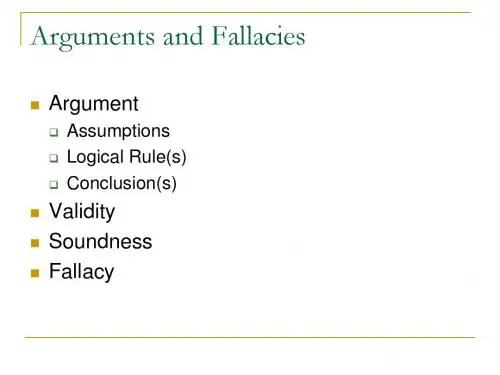
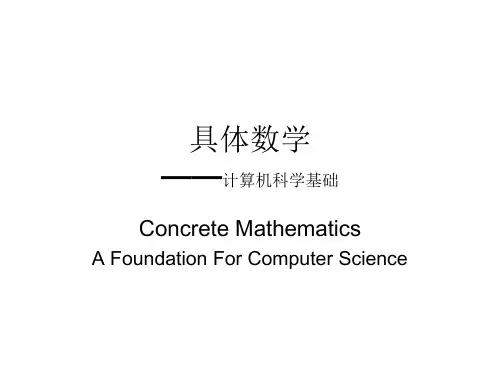


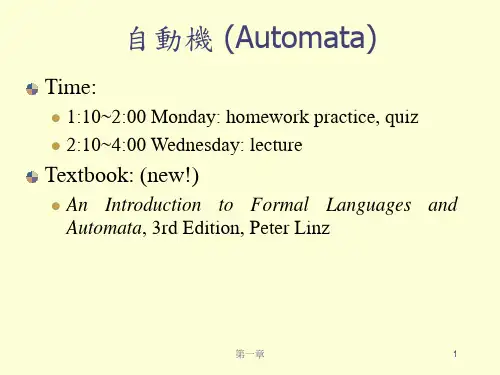

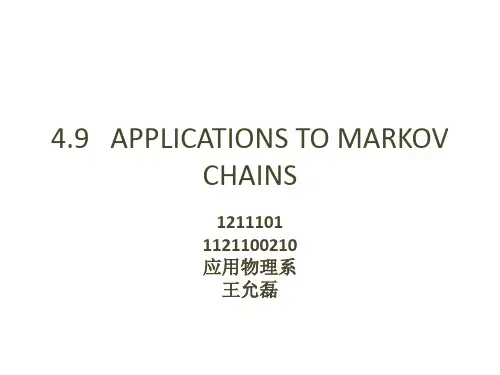
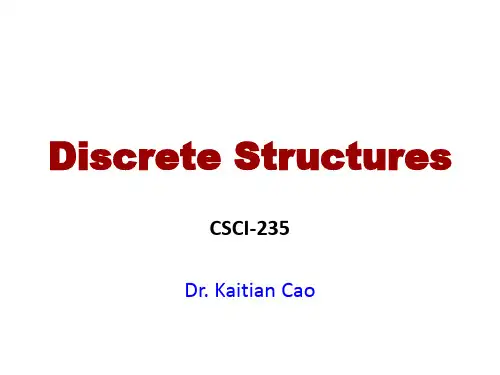
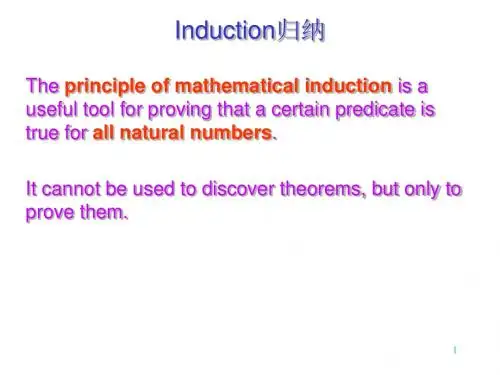
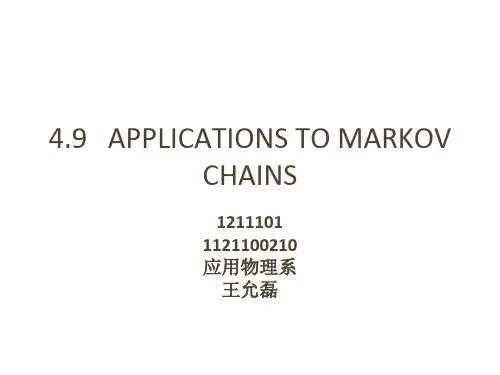
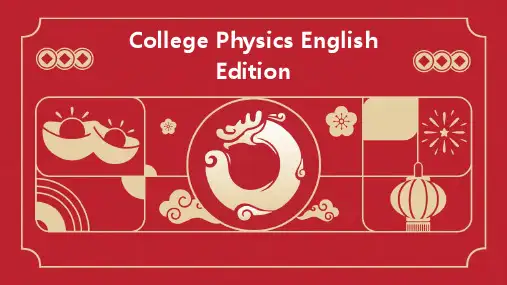
Mathematical proofIn mathematics, a proof is a convincing demonstration (within the accepted standards of the field) that some mathematical statement is necessarily true. Proofs are obtained from deductive reasoning, rather than from inductive or empirical arguments. That is, a proof must demonstrate that a statement is true in all cases, without a single exception. An unproven proposition that is believed to be true is known as a conjecture.The statement that is proved is often called a theorem. Once a theorem is proved, it can be used as the basis to prove further statements. A theorem may also be referred to as a lemma, especially if it is intended for use as a stepping stone in the proof of another theorem.Proofs employ logic but usually include some amount of natural language which usually admits some ambiguity. In fact, the vast majority of proofs in written mathematics can be considered as applications of rigorous informal logic. Purely formal proofs, written in symbolic language instead of natural language, are considered in proof theory. The distinction between formal and informal proofs has led to much examination of current and historical mathematical practice,quasi-empiricism in mathematics, and so-called folk mathematics (in both senses of that term). The philosophy of mathematics is concerned with the role of language and logic in proofs, and mathematics as a language.History and etymologyThe word Proof comes from the Latin probare meaning "to test". Related modern words are the English "probe", "proboscis”, "probation", and "probability", the Spanish "probar" (to smell or taste, or (lesser use) touch or test),[3] Italian "provare" (to try), and the German "probieren" (to try). The early use of "probity" was in the presentation of legal evidence. A person of authority, such as a nobleman, was said to have probity, whereby the evidence was by his relative authority, which outweighed empirical testimony.Plausibility arguments using heuristic devices such as pictures and analogies preceded strict mathematical proof. It is probable that the idea of demonstrating a conclusion first arose in connection with geometry, which originally meant the same as "land measurement". The development of mathematical proof is primarily the product of ancient Greek mathematics, and one of its greatest achievements. Thales (624–546 BCE) proved some theorems in geometry. Eudoxus (408–355 BCE) and Theaetetus (417–369 BCE) formulated theorems but did not prove them. Aristotle (384–322 BCE) said definitions should describe the concept being defined in terms of other concepts already known. Mathematical proofs were revolutionized by Euclid (300 BCE), who introduced the axiomatic method still in use today, starting with undefined terms and axioms (propositions regarding the undefined terms assumed to be self-evidently true from the Greek “axios” meaning“something worthy”), and used these to prove theorem s using deductive logic. His book, the Elements, was read by anyone who was considered educated in the West until the middle of the 20th century. In addition to the familiar theorems of geometry, such as the Pythagorean theorem, the Elements includes a proof that the square root of two is irrational and that there are infinitely many prime numbers.Further advances took place in medieval Islamic mathematics. While earlier Greek proofs were largely geometric demonstrations, the development of arithmetic and algebra by Islamic mathematicians allowed more general proofs that no longer depended on geometry. In the 10th century CE, the Iraqi mathematician Al-Hashimi provided general proofs for numbers (rather than geometric demonstrations) as he considered multiplication, division, etc. for ”lines.” He used this method to provide a proof of the existence of irrational numbers. An inductive proof for arithmetic sequences was introduced in the Al-Fakhri (1000) by Al-Karaji, who used it to prove the binomial theorem and properties of Pascal's triangle. Alhazen also developed the method of proof by contradiction, as the first attempt at proving the Euclidean parallel postulate.Modern proof theory treats proofs as inductively defined data structures. There is no longer an assumption that axioms are "true" in any sense; this allows for parallel mathematicaltheories built on alternate sets of axioms (see Axiomatic set theory and Non-Euclidean geometry for examples).Nature and purposeThere are two different conceptions of mathematical proof. The first is an informal proof, a rigorous natural-language expression that is intended to convince the audience of the truth of a theorem. Because of their use of natural language, the standards of rigor for informal proofs will depend on the audience of the proof. In order to be considered a proof, however, the argument must be rigorous enough; a vague or incomplete argument is not a proof. Informal proofs are the type of proof typically encountered in published mathematics. They are sometimes called "formal proofs" because of their rigor, but logicians use the term "formal proof" to refer to a different type of proof entirely.In logic, a formal proof is not written in a natural language, but instead uses a formal language consisting of certain strings of symbols from a fixed alphabet. This allows the definition of a formal proof to be precisely specified without any ambiguity. The field of proof theory studies formal proofs and their properties. Although each informal proof can, in theory, be converted into a formal proof, this is rarely done in practice. The study of formal proofs is used to determine properties of provability in general, and to show that certain undecidable statements are not provable.A classic question in philosophy asks whether mathematical proofs are analytic or synthetic. Kant, who introduced the analytic-synthetic distinction, believed mathematical proofs are synthetic.Proofs may be viewed as aesthetic objects, admired for their mathematical beauty. The mathematician Paul Erdős was known for describing proofs he found particularly elegant as coming from "The Book", a hypothetical tome containing the most beautiful method(s) of proving each theorem. The book Proofs from THE BOOK, published in 2003, is devoted to presenting 32 proofs its editors find particularly pleasing.Methods of proofMain article: Direct proofIn direct proof, the conclusion is established by logically combining the axioms, definitions, and earlier theorems. For example, direct proof can be used to establish that the sum of two even integers is always even:Consider two even integers x and y. Since they are even, they can be written as x=2a and y=2b respectively for integers a andb. Then the sum x + y = 2a + 2b = 2(a + b). From this it is clearx+y has 2 as a factor and therefore is even, so the sum of any two even integers is even.This proof uses definition of even integers, as well as distribution law.Proof by mathematical inductionMain article: Mathematical inductionIn proof by mathematical induction, first a "base case" is proved, and then an "induction rule" is used to prove a (often infinite) series of other cases. Since the base case is true, the infinity of other cases must also be true, even if all of them cannot be proved directly because of their infinite number.A subset of induction is infinite descent. Infinite descent can be used to prove the irrationality of the square root of two.The principle of mathematical induction states that: Let N = { 1, 2, 3, 4, ... } be the set of natural numbers and P(n) be a mathematical statement involving the natural number n belonging to N such that∙(i)P(1) is true, i.e., P(n) is true for n = 1∙(ii)P(n + 1) is true whenever P(n) is true, i.e., P(n) is true implies that P(n + 1) is true.Then P(n) is true for all natural numbers n.Mathematicians often use the term "proof by induction" as shorthand for a proof by mathematical induction. However, the term "proof by induction" may also be used in logic to mean an argument that uses inductive reasoning.Proof by transpositionMain article: Transposition (logic)Proof by transposition or proof by contrapositive establishes the conclusion "if p then q" by proving the equivalent contrapositive statement "if not q then not p".Example:∙Proposition: If x² is even then x is even.∙Contrapositive proof:If x is odd (not even) then x = 2k + 1 for an integer k. Thus x² = (2k + 1)² = 4k² + 4k + 1 = 2(2k² + 2k) + 1, where (2k² + 2k) is integer. Therefore x² is odd (not ev en).To see the original proposition, suppose x² is even. If x were odd, then we just showed x² would be odd, even though it is supposed to be even; so this case is impossible. The only other possibility is that x is even.Proof by contradictionMain article: Proof by contradictionIn proof by contradiction (also known as reductio ad absurdum, Latin for "by reduction toward the absurd"), it is shown that if some statement were so, a logical contradiction occurs, hence the statement must be not so. This method is perhaps the most prevalent of mathematical proofs. A famousexample of proof by contradiction shows that is an irrational number:Suppose that were a rational number, so by definitionwhere a and b are non-zero integers with no common factor.Thus, . Squaring both sides yields 2b2 = a2. Since 2 divides the left hand side, 2 must also divide the right hand side (as they are equal and both integers). So a2 is even, which implies that a must also be even. So we can write a = 2c, where c is also an integer. Substitution into the original equation yields 2b2 = (2c)2 = 4c2. Dividing both sides by 2 yields b2 = 2c2. But then, by the same argument as before, 2 divides b2, so b must be even.However, if a and b are both even, they share a factor, namely 2.This contradicts our assumption, so we are forced to conclude that is an irrational number.Students can easily fall into erroneous proofs with this method. In searching for a direct proof, a mistake in reasoning will lead to false conclusions, which can often be detected as absurd, alerting the student to his or her error. But in constructing a proof by contradiction, a mistake in reasoning which implies absurd statements tends to be seen as the successful end of the proof.Proof by constructionMain article: Proof by constructionProof by construction, or proof by example, is the construction of a concrete example with a property to show thatsomething having that property exists. Joseph Liouville, for instance, proved the existence of transcendental numbers by constructing an explicit example.Proof by exhaustionMain article: Proof by exhaustionIn proof by exhaustion, the conclusion is established by dividing it into a finite number of cases and proving each one separately. The number of cases sometimes can become very large. For example, the first proof of the four color theorem was a proof by exhaustion with 1,936 cases. This proof was controversial because the majority of the cases were checked by a computer program, not by hand. The shortest known proof of the four colour theorem today still has over 600 cases.Probabilistic proofMain article: Probabilistic methodA probabilistic proof is one in which an example is shown to exist, with certainty, by using methods of probability theory. This is not to be confused with an argument that a theorem is 'probably' true. The latter type of reasoning can be called a 'plausibility argument' and is not a proof; in the case of the Collatz conjecture it is clear how far that is from a genuine proof. Probabilistic proof, like proof by construction, is one of many ways to show existence theorems.Combinatorial proofMain article: Combinatorial proofA combinatorial proof establishes the equivalence of different expressions by showing that they count the same object in different ways. Often a bijection between two sets is used to show that the expressions for their two sizes are equal. Alternatively, a double counting argument provides two different expressions for the size of a single set, again showing that the two expressions are equal.Nonconstructive proofMain article: Nonconstructive proofA nonconstructive proof establishes that a certain mathematical object must exist (e.g. "Some X satisfies f(X)"), without explaining how such an object can be found. Often, this takes the form of a proof by contradiction in which the nonexistence of the object is proved to be impossible. In contrast, a constructive proof establishes that a particular object exists by providing a method of finding it. A famous example of a nonconstructive proof shows that there exist two irrational numbers a and b such that a b is a rational number:Visual proofAlthough not a formal proof, a visual demonstration of a mathematical theorem is sometimes called a "proof without words". The left-hand picture below is an example of a historicvisual proof of the Pythagorean theorem in the case of the (3,4,5) triangle.∙Visual proof for the (3, 4, 5) triangle as in the Chou Pei Suan Ching 500–200 BC.∙Visual proof for the Pythagorean theorem by rearrangement. Elementary proofMain article: Elementary proofAn elementary proof is a proof which only uses basic techniques. More specifically, the term is used in number theory to refer to proofs that make no use of complex analysis. For some time it was thought that certain theorems, like the prime number theorem, could only be proved using "higher" mathematics. However, over time, many of these results have been reproved using only elementary techniques.Two-column proofA two-column proof published in 1913A particular form of proof using two parallel columns is often used in elementary geometry classes in the United States. The proof is written as a series of lines in two columns. In each line, the left-hand column contains a proposition, while the right-hand column contains a brief explanation of how the corresponding proposition in the left-hand column is either an axiom, a hypothesis, or can be logically derived from previous propositions. The left-hand column is typicallyheaded "Statements" and the right-hand column is typically headed "Reasons".Statistical proofs in pure mathematicsMain article: Statistical proofThe expression "statistical proof" may be used technically or colloquially in areas of pure mathematics, such as involving cryptography, chaotic series, and probabilistic or analytic number theory. It is less commonly used to refer to a mathematical proof in the branch of mathematics known as mathematical statistics. See also "Statistical proof using data" section below.Computer-assisted proofsMain article: Computer-assisted proofUntil the twentieth century it was assumed that any proof could, in principle, be checked by a competent mathematician to confirm its validity. However, computers are now used both to prove theorems and to carry out calculations that are too long for any human or team of humans to check; the first proof of the four color theorem is an example of a computer-assisted proof. Some mathematicians are concerned that the possibility of an error in a computer program or a run-time error in its calculations calls the validity of such computer-assisted proofs into question. In practice, the chances of an error invalidating a computer-assisted proof can be reduced byincorporating redundancy and self-checks into calculations, and by developing multiple independent approaches and programs. Furthermore, although a computer might make a mistake when checking a proof, errors can never be completely ruled out in case of a human proof verifier as well, especially if the proof contains natural language and requires mathematical insight.Undecidable statementsA statement that is neither provable nor disprovable from a set of axioms is called undecidable (from those axioms). One example is the parallel postulate, which is neither provable nor refutable from the remaining axioms of Euclidean geometry.Mathematicians have shown there are many statements that are neither provable nor disprovable in Zermelo-Fraenkel set theory with the axiom of choice (ZFC), the standard system of set theory in mathematics (assuming that ZFC is consistent); see list of statements undecidable in ZFC.Gödel's (first) incomplete ness theorem shows that many axiom systems of mathematical interest will have undecidable statements.Heuristic mathematics and experimental mathematicsMain article: Experimental mathematicsWhile early mathematicians such as Eudoxus of Cnidus did not use proofs, from Euclid to the foundational mathematics developments of the late 19th and 20th centuries, proofs werean essential part of mathematics. With the increase in computing power in the 1960s, significant work began to be done investigating mathematical objects outside of theproof-theorem framework, in experimental mathematics. Early pioneers of these methods intended the work ultimately to be embedded in a classical proof-theorem framework, e.g. the early development of fractal geometry, which was ultimately so embedded.Related conceptsColloquial use of "mathematical proof"The expression "mathematical proof" is used by lay people to refer to using mathematical methods or arguing with mathematical objects, such as numbers, to demonstrate something about everyday life, or when data used in an argument are numbers. It is sometime also used to mean a "statistical proof" (below), especially when used to argue from data.Statistical proof using dataMain article: Statistical proof"Statistical proof" from data refers to the application of statistics, data analysis, or Bayesian analysis to infer propositions regarding the probability of data. While using mathematical proof to establish theorems in statistics, it is usually not a mathematical proof in that the assumptions from which probability statements are derived require empiricalevidence from outside mathematics to verify. In physics, in addition to statistical methods, "statistical proof" can refer to the specialized mathematical methods of physics applied to analyze data in a particle physics experiment or observational study in cosmology. "Statistical proof" may also refer to raw data or a convincing diagram involving data, such as scatter plots, when the data or diagram is adequately convincing without further anaylisis.Inductive logic proofs and Bayesian analysisMain articles: Inductive logic and Bayesian analysisProofs using inductive logic, while considered mathematical in nature, seek to establish propositions with a degree of certainty, which acts in a similar manner to probability, and may be less than one certainty. Bayesian analysis establishes assertions as to the degree of a person's subjective belief. Inductive logic should not be confused with mathematical induction.Proofs as mental objectsMain articles: Psychologism and Language of thoughtPsychologism views mathematical proofs as psychological or mental objects. Mathematician philosophers, such as Leibniz, Frege, and Carnap, have attempted to develop a semantics for what they considered to be the language of thought, wherebystandards of mathematical proof might be applied to empirical science.Influence of mathematical proof methods outside mathematicsPhilosopher-mathematicians such as Schopenhauer have attempted to formulate philosophical arguments in an axiomatic manner, whereby mathematical proof standards could be applied to argumentation in general philosophy. Other mathematician-philosophers have tried to use standards of mathematical proof and reason, without empiricism, to arrive at statements outside of mathematics, but having the certainty of propositions deduced in a mathematical proof, such as Descarte’s cogito argument.Ending a proofMain article: Q.E.D.Sometimes, the abbreviation "Q.E.D."is written to indicate the end of a proof. This abbreviation stands for "Quod Erat Demonstrandum", which is Latin for "that which was to be demonstrated". A more common alternative is to use a square or a rectangle, such as □ or ∎, known as a "tombstone" or "halmos" after its eponym Paul Halmos. Often, "which was to be shown" is verbally stated when writing "QED", "□", or "∎" in an oral presentation on a board.。
c 2007The Author(s)and The IMO Compendium GroupFunctional EquationsMarko Radovanovi´cradmarko@Contents1Basic Methods For Solving Functional Equations (1)2Cauchy Equation and Equations of the Cauchy type (2)3Problems with Solutions (2)4Problems for Independent Study (14)1Basic Methods For Solving Functional Equations•Substituting the values for variables.The most commonfirst attempt is with some constants (eg.0or1),after that(if possible)some expressions which will make some part of the equation to become constant.For example if f(x+y)appears in the equations and if we have found f(0)then we plug y=−x.Substitutions become less obvious as the difficulty of the problems increase.•Mathematical induction.This method relies on using the value f(1)tofind all f(n)for n integer.After that wefind f 12Olympiad Training Materials, •Analyzing the set of values for which the function is equal to the assumed solution.The goal is to prove that the described set is precisely the domain of the function.•Substituting the function.This method is often used to simplify the given equation and is seldom of crucial importance.•Expressing functions as sums of odd and ly each function can be represented as a sum of one even and one odd function and this can be very handy in treating”linear”functional equations involving many functions.•Treating numbers in a system with basis different than10.Of course,this can be used only if the domain is N.•For the end let us emphasize that it is very important to guess the solution at the beginning.This can help a lot infinding the appropriate substitutions.Also,at the end of the solution, DON’T FORGET to verify that your solution satisfies the given condition.2Cauchy Equation and Equations of the Cauchy typeThe equation f(x+y)=f(x)+f(y)is called the Cauchy equation.If its domain is Q,it is well-known that the solution is given by f(x)=x f(1).That fact is easy to prove using mathematical induction.The next problem is simply the extention of the domain from Q to R.With a relatively easy counter-example we can show that the solution to the Cauchy equation in this case doesn’t have to be f(x)=x f(1).However there are many additional assumptions that forces the general solution to be of the described ly if a function f satisfies any of the conditions:•monotonicity on some interval of the real line;•continuity;•boundedness on some interval;•positivity on the ray x≥0;then the general solution to the Cauchy equation f:R→S has to be f(x)=x f(1).The following equations can be easily reduced to the Cauchy equation.•All continuous functions f:R→(0,+∞)satisfying f(x+y)=f(x)f(y)are of the form f(x)=a ly the function g(x)=log f(x)is continuous and satisfies the Cauchy equa-tion.•All continuous functions f:(0,+∞)→R satisfying f(xy)=f(x)+f(y)are of the form f(x)=log a x.Now the function g(x)=f(a x)is continuous and satisfies the Cauchy equation.•All continuous functions f:(0,+∞)→(0,+∞)satisfying f(xy)=f(x)f(y)are f(x)=x t, where t=log a b and f(a)=b.Indeed the function g(x)=log f(a x)is continuous and satisfies the Cauchy equation.3Problems with SolutionsThe following examples should illustrate the previously outlined methods.Problem1.Find all functions f:Q→Q such that f(1)=2and f(xy)=f(x)f(y)−f(x+y)+1.Marko Radovanovi´c :Functional Equations 3Solution.This is a classical example of a problem that can be solved using mathematical induction.Notice that if we set x =1and y =n in the original equation we get f (n +1)=f (n )+1,and since f (1)=2we have f (n )=n +1for every natural number n .Similarly for x =0and y =n we get f (0)n =f (n )−1=n ,i.e.f (0).Now our goal is to find f (z )for each z ∈Z .Substituting x =−1and y =1in the original equation gives us f (−1)=0,and setting x =−1and y =n gives f (−n )=−f (n −1)+1=−n +1.Hence f (z )=z +1for each z ∈Z .Now we have to determine f 1nwe get f (1)=(n +1)f 1n+1.(1)Furthermore for x =1and y =m +1n =f m +1n=m +f 1n=1n we get f m n +1,i.e.f (r )=r +1,for every positive rational number r .Setting x =−1and y =r we get f (−r )=−f (r −1)+1=−r +1as well hence f (x )=x +1,for each x ∈Q .Verification:4Olympiad Training Materials,Solution.Setting m=1and nfirst,and m=n,n=1afterwards we getf(f(1)+f(n))=f(f(1))+f(n),f(f(n)+f(1))=f(f(n))+f(1).Let us emphasize that this is one standard idea if the expression on one side is symmetric with respect to the variables while the expression on the other side is not.Now we have f(f(n))= f(n)−f(1)+f(f(1))=f(n)−2+f(2)=f(n)+2.From here we conclude that f(n)=m implies f(m)=m+2and now the induction gives f(m+2k)=m+2k+2,for every k≥0.Specially if f(1)=2then f(2n)=2n+2for all positive integers n.The injectivity of f gives that at odd numbers(except1)the function has to take odd values.Let p be the smallest natural number such that for some k f(k)=2p+1.We have f(2p+2s+1)=2p+2s+3for s≥0.Therefore the numbers3,5,...,2p−1are mapped into1,3,...,2p+1.If f(t)=1for some t,then for m=n=t 4=f(2)=f(f(t)+f(t))=f(f(t))+f(t)=3,which is a contradiction.If for some t such that f(t)=3then f(3+2k)=5+2k,which is a contradiction to the existence of such t.It follows that the numbers3,5,...,2p−1are mapped into5,7,...,2p+1.Hence f(3+2k)=5+2k.Thus the solution is f(1)=2and f(n)=n+2,for n≥2.It is easy to verify that the function satisfies the given conditions.△Problem5.(BMO1997,2000)Solve the functional equationf(x f(x)+f(y))=y+f(x)2,x,y∈R.Solution.In probelms of this type it is usually easy to prove that the functions are injective or surjective,if the functions are injective/surjective.In this case for x=0we get f(f(y))=y+f(0)2. Since the function on the right-hand side is surjective the same must hold for the function on the left-hand side.This implies the surjectivity of f.Injectivity is also easy to establish.Now there exists t such that f(t)=0and substitution x=0and y=t yields f(0)=t+f(0)2.For x=t we get f(f(y))=y.Therefore t=f(f(t))=f(0)=t+f(0)2,i.e.f(0)=0.Replacing x with f(x)givesf(f(x)x+f(y))=x2+y,hence f(x)2=x2for every real number x.Consider now the two cases:First case f(1)=1.Plugging x=1gives f(1+f(y))=1+y,and after taking squares(1+y)2= f(1+f(y))2=(1+f(y))2=1+2f(y)+f(y)2=1+2f(y)+y2.Clearly in this case we have f(y)=y for every real y.Second case f(1)=−1.Plugging x=−1gives f(−1+f(y))=1+y,and after taking squares (1+y)2=f(−1+f(y))2=(−1+f(y))2=1−2f(y)+f(y)2=1−2f(y)+y2.Now we conclude f(y)=−y for every real number y.It is easy to verify that f(x)=x and f(x)=−x are indeed the solutions.△Problem6.(IMO1979,shortlist)Given a function f:R→R,if for every two real numbers x and y the equality f(xy+x+y)=f(xy)+f(x)+f(y)holds,prove that f(x+y)=f(x)+f(y)for every two real numbers x and y.Solution.This is a clasical example of the equation that solution is based on a careful choice of values that are plugged in a functional equation.Plugging in x=y=0we get f(0)=0.Plugging in y=−1we get f(x)=−f(−x).Plugging in y=1we get f(2x+1)=2f(x)+f(1)and hence f(2(u+v+uv)+1)=2f(u+v+uv)+f(1)=2f(uv)+2f(u)+2f(v)+f(1)for all real u and v.On the other hand,plugging in x=u and y=2v+1we get f(2(u+v+uv)+1)=f(u+(2v+1)+u(2v+ 1))=f(u)+2f(v)+f(1)+f(2uv+u).Hence it follows that2f(uv)+2f(u)+2f(v)+f(1)= f(u)+2f(v)+f(1)+f(2uv+u),i.e.,f(2uv+u)=2f(uv)+f(u).(1) Plugging in v=−1/2we get0=2f(−u/2)+f(u)=−2f(u/2)+f(u).Hence,f(u)=2f(u/2)and consequently f(2x)=2f(x)for all reals.Now(1)reduces to f(2uv+u)=f(2uv)+f(u).Plugging in u=y and x=2uv,we obtain f(x)+f(y)=f(x+y)for all nonzero reals x and y.Since f(0)=0, it trivially holds that f(x+y)=f(x)+f(y)when one of x and y is0.△Marko Radovanovi´c:Functional Equations5Problem7.Does there exist a function f:R→R such that f(f(x))=x2−2for every real number x?Solution.After some attempts we can see that none of thefirst three methods leads to a progress. Notice that the function g of the right-hand side has exactly2fixed points and that the function g◦g has exactly4fixed points.Now we will prove that there is no function f such that f◦f=g.Assume the contrary.Let a,b be thefixed points of g,and a,b,c,d thefixed points of g◦g.Assume that g(c)=y.Then c=g(g(c))=g(y),hence g(g(y))=g(c)=y and y has to be on of thefixed points of g◦g.If y=a then from a=g(a)=g(y)=c we get a contradiction.Similarly y=b,and since y=c we get y=d.Thus g(c)=d and g(d)=c.Furthermore we have g(f(x))=f(f(f(x)))=f(g(x)). Let x0∈{a,b}.We immediately have f(x0)=f(g(x0))=g(f(x0)),hence f(x0)∈{a,b}.Similarly if x1∈{a,b,c,d}we get f(x1)∈{a,b,c,d},and now we will prove that this is not possible.Take first f(c)=a.Then f(a)=f(f(c))=g(c)=d which is clearly impossible.Similarly f(c)=b and f(c)=c(for otherwise g(c)=c)hence f(c)=d.However we then have f(d)=f(f(c))=g(c)=d, which is a contradiction,again.This proves that the required f doesn’t exist.△Problem8.Find all functions f:R+→R+such that f(x)f(y f(x))=f(x+y)for every two positive real numbers x,y.Solution.Obviously f(x)≡1is one solution to the problem.The idea is tofind y such that y f(x)= x+y and use this to determine f(x).For every x such thatx3in the given equation we get the obviouscontradiction.This means that the function is decreasing and hence it is injective.Again everything will revolve around the idea of getting rid of f(y f(x)).Notice that x+y>y f(x),thereforef(x)f(y f(x))=f(x+y)=f(y f(x)+x+y−y f(x))=f(y f(x))f f y f(x) (x+y−y f(x)) , i.e.f(x)=f f y f(x) (x+y−y f(x)) .The injectivity of f implies that x=f y f(x) (x+y−y f(x)).If we plug f(x)=a we getf(y)=1a f(a),and according to our assumptionα>0.It is easy to verify that f(x)=11+cand g(x)=cx−c2,c∈R\{−1}.6Olympiad Training Materials, Now we prove the existence of αsuch that g (α)=0.If f (0)=0then putting y =0in the given equation we obtain f (x +g (0))=g (x ),so we can take α=−g (0).Now assume that f (0)=b =0.By replacing x by g (x )in the given equation we obtain f (g (x )+g (y ))=g (x )f (y )−y f (g (x ))+g (g (x ))and,analogously,f (g (x )+g (y ))=g (y )f (x )−x f (g (y ))+g (g (y )).The given functional equation for x =0gives f (g (y ))=a −by ,where a =g (0).In partic-ular,g is injective and f is surjective,so there exists c ∈R such that f (c )=0.Now the above two relations yieldg (x )f (y )−ay +g (g (x ))=g (y )f (x )−ax +g (g (y )).(1)Plugging y =c in (1)we get g (g (x ))=g (c )f (x )−ax +g (g (c ))+ac =k f (x )−ax +d .Now (1)becomes g (x )f (y )+k f (x )=g (y )f (x )+k f (y ).For y =0we have g (x )b +k f (x )=a f (x )+kb ,whence g (x )=a −k 2∈F ,hence α≤13.The idea is the following:Denote12.This would imply that α≥12.Let us constract a recurrent relation for αk .Assume that f (x )≥αk x ,for every x ∈R +.From thegiven inequality we havef (3x )≥f (f (2x ))+x ≥αk f (2x )+x ≥αk ·αk ·2x +x =αk +1·3x .This means that αn +1=2α2n+12.This is a standard problem.It is easy to prove that the sequence αk is increasing and bounded above by13,i.e.α=1Marko Radovanovi´c:Functional Equations7 Solution.Ourfirst goal is to express f and g using h and get the equation involving h only.Firsttaking y=x and substituting g(0)=a we get f(2x)=4h(x)−a.Furthermore by putting y=0we get g(x)=2h(x)+2b−4h xx−y2 +hx+y2 +H e8Olympiad Training Materials,1.1◦If f(1)=0,then from(5)plugging y+1instead of y we get f(y)=f(−y).Setting−yinstead of y in the initial equality gives f(xy)=f(x)f(y)−f(x−y)+1,hence f(x+y)=f(x−y),for every two rational numbers x and y.Specially for x=y we get f(2x)=f(0)=1,for all x∈Q.However this is a contradiction with f(1)=0.In this case wedon’t have a solution.1.2◦If f(1)=2,setting y+1instead of y in(5)gives1−f(y)=f(−y)−1.It is clearthat we should do the substitution g(x)=1−f(x)because the previous equality givesg(−x)=−g(x),i.e.g is odd.Furthermore substituting g into the original equality givesg(xy)=g(x)+g(y)−g(x)g(y)−g(x+y).(6) Setting−y instead of y we get−g(xy)=g(x)−g(y)+g(x)g(y)−g(x−y),and addingwith(6)yields g(x+y)+g(x−y)=2g(x).For x=y we have g(2x)=2g(x)therefore weget g(x+y)+g(x−y)=g(2x).This is a the Cauchy equation and since the domain is Qwe get g(x)=rx for some rational number r.Plugging this back to(6)we obtain r=−1,and easy verification shows that f(x)=1+x satisfies the conditions of the problem.2◦Let f(1)=1.Setting z=1in(4)we getf(xy+1)−f(x)f(y+1)+f(x)=1,hence for y=−1we get f(1−x)=1,for every rational x.This means that f(x)≡1and this function satisfies the given equation.Now let us solve the problem where f:R→R.Notice that we haven’t used that the range is Q, hence we conclude that for all rational numbers q f(q)=q+1,or f(q)≡1.If f(q)=1for all rational numbers q,it can be easily shown that f(x)≡1.Assume that f(q)≡1.From the above we have that g(x)+g(y)=g(x+y),hence it is enough to prove monotonicity.Substitute x=y in (6)and use g(2x)=2g(x)to get g(x2)=−g(x)2.Therefore for every positive r the value g(r)is non-positive.Hence if y>x,i.e.y=x+r2we have g(y)=g(x)+g(r2)≤g(x),and the function is decreasing.This means that f(x)=1+αx and after some calculation we get f(x)=1+x.It is easy to verify that so obtained functions satisfy the given functional equation.△Problem14.(IMO2003,shortlist)Let R+denote the set of positive real numbers.Find all functions f:R+→R+that satisfy the following conditions:(i)f(xyz)+f(x)+f(y)+f(z)=f(√yz)f(√x which tells us that thisequality is unlikely to be shown reducing to the Cauchy equation.First,setting x=y=z=1we get f(1)=2(since f(1)>0).One of the properties of the solution suggested above is f(x)=f(1/x), and proving this equality will be our next step.Putting x=ts,y=ttin(i)givesf(t)f(s)=f(ts)+f(t/s).(7) In particular,for s=1the last equality yields f(t)=f(1/t);hence f(t)≥f(1)=2for each t.It follows that there exists g(t)≥1such that f(t)=g(t)+1Marko Radovanovi´c:Functional Equations9Problem15.Find all functions f:[1,∞)→[1,∞)that satisfy:(i)f(x)≤2(1+x)for every x∈[1,∞);(ii)x f(x+1)=f(x)2−1for every x∈[1,∞).Solution.It is not hard to see that f(x)=x+1is a solution.Let us prove that this is the only ing the given conditions we getf(x)2=x f(x+1)+1≤x(2(x+1))+1<2(1+x)2,i.e.f(x)≤√2(x+1))+1<21/4(1+x)2.Now it is clear that we should use induction to provef(x)<21/2k(1+x),for every k.However this is shown in the same way as the previous two inequalities.Since21/2k→1 as k→+∞,hence forfixed x we can’t have f(x)>x+1.This implies f(x)≤x+1for every real number x≥1.It remains to show that f(x)≥x+1,for x≥1.We will use the similar argument. From the fact that the range is[1,+∞)we getf(x)2−1x+1>x1/2. We further have f(x)2=1+x f(x+1)>1+x√2k ,andpassing to the limit we get the required inequality f(x)≥x+1.△Problem16.(IMO1999,probelm6)Find all functions f:R→R such thatf(x−f(y))=f(f(y))+x f(y)+f(x)−1.Solution.Let A={f(x)|x∈R},i.e.A=f(R).We will determine the value of the function on A. Let x=f(y)∈A,for some y.From the given equality we have f(0)=f(x)+x2+f(x)−1,i.e.f(x)=c+12,where f(0)=c.Now it is clear that we have to analyze set A further.Setting x=y=0in the original equation we get f(−c)=f(c)+c−1,hence c=0.Furthermore,plugging y=0in the original equation we get f(x−c)−f(x)=cx+f(c)−1.Since the range of the function(on x)on the right-hand side is entire R,we get{f(x−c)−f(x)|x∈R}=R,i.e.A−A=R.Hence for every real number x there are real numbers y1,y2∈A such that x=y1−y2.Now we havef(x)=f(y1−y2)=f(y1−f(z))=f(f(z))+y1f(z)+f(y1)−1=f(y1)+f(y2)+y1y2−1=c−x22 satisfies the given equation.△10Olympiad Training Materials, Problem 17.Given an integer n,let f :R →R be a continuous function satisfying f (0)=0,f (1)=1,and f (n )(x )=x,for every x ∈[0,1].Prove that f (x )=x for each x ∈[0,1].Solution.First from f (x )=f (y )we have f (n )(x )=f (n )(y ),hence f is injective.The idea for what follows is clear once we look at the graphical ly from the picture it can be easily deduced that the function has to be strictly increasing.Let us prove that formally.Assume the contrary,that for some two real numbers x 1<x 2we have f (x 1)≥f (x 2).The continuity on [0,x 1]implies that there is some c such that f (c )=f (x 2),which contradicts the injectivity of f .Now if x <f (x ),we get f (x )<f (f (x ))etc.x <f (n )(x )=x .Similarly we get a contradiction if we assume that x >f (x ).Hence for each x ∈[0,1]we must have f (x )=x .△Problem 18.Find all functions f :(0,+∞)→(0,+∞)that satisfy f (f (x )+y )=x f (1+xy )for all x ,y ∈(0,+∞).Solution.Clearly f (x )=1y −x since it is positive and bigger then f (y ).We first plug (x ,z −f (y ))instead of (x ,y )in the original equation,then we plug z −f (x )instead of y ,we get x =y ,which is a contradiction.Hence the function is non-decreasing.Let us prove that f (1)=1.Let f (1)=1.Substituting x =1we get f (f (1)+y )=f (1+y ),hence f (u +|f (1)−1|)=f (u )for u >1.Therefore the function is periodic on the interval (1,+∞),and since it is monotone it is constant.However we then conclude that the left-hand side of the original equation constant and the right-hand side is not.Thus we must have f (1)=1.Let us prove that f (x )=1x the given equality gives f f (x )−1x we have f f (x )−1x we have f f (x )−1x .If x <1,plugging y =1x=x f (2)=x x ≥1,we get f (x )+1x ,i.e.f (x )=1x for all positive real numbers x .△Problem 19.(Bulgaria 1998)Prove that there is no function f :R +→R +such that f (x )2≥f (x +y )(f (x )+y )for every two positive real numbers x and y.Solution.The common idea for the problems of this type is to prove that f (y )<0for some y >0which will lead us to the obvious contradiction.We can also see that it is sufficient to prove that f (x )−f (x +1)≥c >0,for every x because the simple addition gives f (x )−f (x +m )≥mc .For sufficiently large m this implies f (x +m )<0.Hence our goal is finding c such that f (x )−f (x +1)≥c ,for every x .Assume that such function exists.From the given inequality we get f (x )−f (x +y )≥f (x +y )yf (x )+y.Let n be a natural number such that f (x +1)n ≥1(such number clearly exists).Notice that for 0≤k ≤n −1the following inequality holds f x +k n ≥f x +k n n +12n ,and adding similar realitions for all described k yields f(x)−f(x+1)≥12003 if f:Q→[0,+∞)is the function satisfying the conditions:(i)f(xy)=f(x)f(y)for all x,y∈Q;(ii)f(x)≤1⇒f(x+1)≤1for all x∈Q;(iii)f 2003x f(y)=f(x)we have that f yx+1 ≤1.This impliesf(x+y)=f y2002 =f(2003)2003 =f(2)2f(3)f(167)If f(2)=1/2then f 20034,otherwise it is1.It remains to construct one function for each of the given values.For thefirst value it is the multiplicative function taking the value1/2at the point2,and1for all other prime numbers;in the second case it is a the multiplicative function that takes the value1/2at,for example,7and takes1 at all other prime numbers.For these functions we only need to verify the condition(ii),but that is also very easy to verify.△Problem22.Let I=[0,1],G=I×I and k∈N.Find all f:G→I such that for all x,y,z∈I the following statements hold:(i)f(f(x,y),z)=f(x,f(y,z));(ii)f(x,1)=x,f(x,y)=f(y,x);(ii)f(zx,zy)=z k f(x,y)for every x,y,z∈I,where k is afixed real number.Solution.The function of several variables appears in this problem.In most cases we use the same methods as in the case of a single-variable functions.From the condition(ii)we get f(1,0)= f(0,1)=0,and from(iii)we get f(0,x)=f(x,0)=x k f(1,0)=0.This means that f is entirely defined on the edge of the region G.Assume therefore that0<x≤y<1.Notice that the condition (ii)gives the value for one class of pairs from G and that each pair in G can be reduced to one of the members of the class.This impliesf(x,y)=f(y,x)=y k f 1,x2≤y<1.From the condition(i),and the already obtained results we getf f x,12 k−1,y =f x,f 12y k−1 .Let us now consider x≤2k−1y in order to simplify the expression to the form f x,12 k−1,and if we take x for which2x≤y k−1we get k−1=(k−1)2,i.e.k=1or k=2. For k=1the solution is f(x,y)=min(x,y),and for k=2the solution is f(x,y)=xy.It is easy to verify that both solutions satisfy the given conditions.△Problem23.(APMO1989)Find all strictly increasing functions f:R→R such thatf(x)+g(x)=2x,where g is the inverse of f.Solution.Clearly every function of the form x+d is the solution of the given equation.Another useful idea appears in this ly denote by S d the the set of all numbers x for which f(x)=x+d.Our goal is to prove that S d=R.Assume that S d is non-empty.Let us prove that for x∈S d we have x+d∈S d as well.Since f(x)=x+d,according to the definition of the inverse function we have g(x+d)=x,and the given equation implies f(x+d)=x+2d,i.e.x+d∈S d.Let us prove that the sets S d′are empty,where d′<d.From the above we have that each of those sets is infinite,i.e.if x belongs to some of them,then each x+kd belongs to it as well.Let us use this to get the contradiction.More precisely we want to prove that if x∈S d and x≤y≤x+(d−d′),then y∈S d′.Assume the contrary.From the monotonicity we have y+d′=f(y)≥f(x)=x+d,which is a contradiction to our assumption.By further induction we prove that every y satisfyingx+k(d−d′)≤y<x+(k+1)(d−d′),can’t be a member of S d ′.However this is a contradiction with the previously established properties of the sets S d and S d ′.Similarly if d ′>d switching the roles of d and d ′gives a contradiction.Simple verification shows that each f (x )=x +d satisfies the given functional equation.△Problem 24.Find all functions h :N →N that satisfyh (h (n ))+h (n +1)=n +2.Solution.Notice that we have both h (h (n ))and h (n +1),hence it is not possible to form a recurrent equation.We have to use another approach to this problem.Let us first calculate h (1)and h (2).Setting n =1gives h (h (1))+h (2)=3,therefore h (h (1))≤2and h (2)≤2.Let us consider the two cases:1◦h (2)=1.Then h (h (1))=2.Plugging n =2in the given equality gives 4=h (h (2))+h (3)=h (1)+h (3).Let h (1)=k .It is clear that k =1and k =2,and that k ≤3.This means that k =3,hence h (3)=1.However from 2=h (h (1))=h (3)=1we get a contradiction.This means that there are no solutions in this case.2◦h (2)=2.Then h (h (1))=1.From the equation for n =2we get h (3)=2.Setting n =3,4,5we get h (4)=3,h (5)=4,h (6)=4,and by induction we easily prove that h (n )≥2,for n ≥2.This means that h (1)=1.Clearly there is at most one function satisfying the given equality.Hence it is enough to guess some function and prove that it indeed solves the equation (induction or something similar sounds fine).The solution ish (n )=⌊n α⌋+1,where α=−1+√2(this constant can be easily found α2+α=1).Proof that this is a solution uses some properties of the integer part (although it is not completely trivial).△Problem 25.(IMO 2004,shortlist)Find all functions f :R →R satisfying the equalityf (x 2+y 2+2f (xy ))=f (x +y )2.Solution.Let us make the substitution z =x +y ,t =xy .Given z ,t ∈R ,x ,y are real if and only if 4t ≤z 2.Define g (x )=2(f (x )−x ).Now the given functional equation transforms intof z 2+g (t ) =(f (z ))2for all t ,z ∈R with z 2≥4t .(8)Let us set c =g (0)=2f (0).Substituting t =0into (8)gives usf (z 2+c )=(f (z ))2for all z ∈R .(9)If c <0,then taking z such that z 2+c =0,we obtain from (9)that f (z )2=c /2,which is impossible;hence c ≥0.We also observe thatx >c implies f (x )≥0.(10)If g is a constant function,we easily find that c =0and therefore f (x )=x ,which is indeed a solution.Suppose g is nonconstant,and let a ,b ∈R be such that g (a )−g (b )=d >0.For some sufficiently large K and each u ,v ≥K with v 2−u 2=d the equality u 2+g (a )=v 2+g (b )by (8)and (10)implies f (u )=f (v ).This further leads to g (u )−g (v )=2(v −u )=d u 2+d.Therefore every value from some suitably chosen segment [δ,2δ]can be expressed as g (u )−g (v ),with u and v bounded from above by some M .√Consider any x,y with y>x≥2M with y2−x2∈[δ,2δ],it follows that f(x)is√eventually constant,say f(x)=k for x≥N=210.Let f:N→N be strictly increasing function that satisfies f(f(n))=3n for every naturalnumber n.Determine f(2006).11.(IMO1989,shortlist)Let0<a<1be a real number and f continuous function on[0,1]which satisfies f(0)=0,f(1)=1,andf x+y7 .12.(IMO1996,shortlist)Let f:R→R be the function such that|f(x)|≤1andf x+136 +f x+1,for all x,y∈Q+.y15.(IMO2002,shortlist)Find all functions f:R→R such thatf(f(x)+y)=2x+f(f(y)−x).16.(Iran1997)Let f:R→R be an increasing function such that for all positive real numbers xand y:f(x+y)+f(f(x)+f(y))=f(f(x+f(y))+f(y+f(x))).Prove that f(f(x))=x.17.(IMO1992,problem2)Find all functions f:R→R,such that f(x2+f(y))=y+f(x)2forall x,y∈R.18.(IMO1994,problem5)Let S be the set of all real numbers strictly greater than-1.Find allfunctions f:S→S that satisfy the following two conditions:(i)f(x+f(y)+x f(y))=y+f(x)+y f(x)for all x,y∈S;f(x)(ii)21.(Vietnam2005)Find all values for a real parameterαfor which there exists exactly onefunction f:R→R satisfyingf(x2+y+f(y))=f(x)2+α·y.22.(IMO1998,problem3)Find the least possible value for f(1998)where f:N→N is a functionthat satisfiesf(n2f(m))=m f(n)2.23.Does there exist a function f:N→N such thatf(f(n−1))=f(n+1)−f(n)for each natural number n?24.(IMO1987,problem4)Does there exist a function f:N0→N0such that f(f(n))=n+1987?25.Assume that the function f:N→N satisfies f(n+1)>f(f(n)),for every n∈N.Prove thatf(n)=n for every n.26.Find all functions f:N0→N0,that satisfy:(i)2f(m2+n2)=f(m)2+f(n)2,for every two natural numbers m and n;(ii)If m≥n then f(m2)≥f(n2).27.Find all functions f:N0→N0that satisfy:(i)f(2)=2;(ii)f(mn)=f(m)f(n)for every two relatively prime natural numbers m and n;(iii)f(m)<f(n)whenever m<n.28.Find all functions f:N→[1,∞)that satisfy conditions(i)and(ii9)of the previous problemand the condition(ii)is modified to require the equality for every two natural numbers m and n.29.Given a natural number k,find all functions f:N0→N0for whichf(f(n))+f(n)=2n+3k,for every n∈N0.30.(Vijetnam2005)Find all functions f:R→R that satisfy f(f(x−y))=f(x)f(y)−f(x)+f(y)−xy.31.(China1996)The function f:R→R satisfy f(x3+y3)=(x+y) f(x)2−f(x)f(y)+f(y)2 ,for all real numbers x and y.Prove that f(1996x)=1996f(x)for every x∈R.32.Find all functions f:R→R that satisfy:(i)f(x+y)=f(x)+f(y)for every two real numbers x and y;(ii)f 1x2for x=0.33.(IMO1989,shortlist)A function f:Q→R satisfy the following conditions:(i)f(0)=0,f(α)>0zaα=0;(ii)f(αβ)=f(α)f(β)i f(α+β)≤f(α)+f(β),for allα,β∈Q;(iii)f(m)≤1989za m∈Z.Prove that f(α+β)=max{f(α),f(β)}whenever f(α)=f(β).34.Find all functions f:R→R such that for every two real numbers x=y the equalityf x+y f(x)−f(y)is satisfied.35.Find all functions f:Q+→Q+satisfying:(i)f(x+1)=f(x)+1for all x∈Q+;(ii)f(x3)=f(x)3for all x∈Q+.36.Find all continuous functions f:R→R that satisfy the equalityf(x+y)+f(xy)=f(x)+f(y)+f(xy+1).37.Find all continuous functions f,g,h,k:R→R that satisfy the equalityf(x+y)+g(x−y)=2h(x)+2k(y).38.(IMO1996,shortlist)Find all functions f:N0→N0such thatf(m+f(n))=f(f(m))+f(n).39.(IMO1995,shortlist)Does there exist a function f:R→R satisfying the conditions:(i)There exists a positive real number M such that−M≤f(x)≤M for all x∈R;(ii)f(1)=1;(iii)If x=0then f x+1x 2?40.(Belarus)Find all continuous functions f:R→R that satisfyf(f(x))=f(x)+2x.41.Prove that if the function f:R+→R satisfy the equalityf x+y x+y =f(x)+f(y),the it satisfy the equality2f(√。